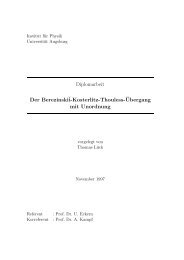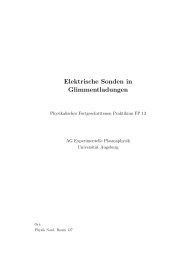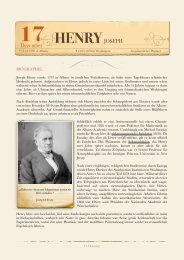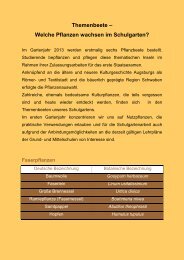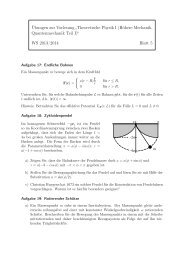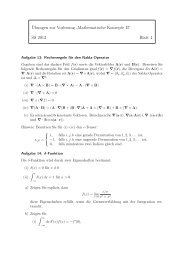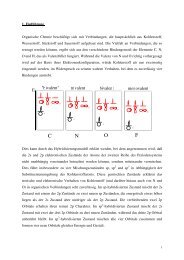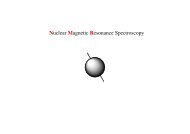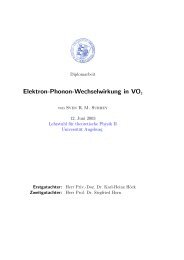Numerical Renormalization Group Calculations for Impurity ...
Numerical Renormalization Group Calculations for Impurity ...
Numerical Renormalization Group Calculations for Impurity ...
Create successful ePaper yourself
Turn your PDF publications into a flip-book with our unique Google optimized e-Paper software.
3.3. Flow diagrams and Fixed points 25<br />
and the subspace of the full Hamiltonian H N with energy 0 ≤ E (N−1)<br />
n<br />
≤ ξ (N−1)<br />
i<br />
can be effectively described by a truncated Hamiltonian H N (N s l ×N s l) where N s<br />
is defined to satisfy<br />
E (N−1)<br />
N s<br />
≈ 2ξ i . (3.48)<br />
The energy cutoff ξ (N−1)<br />
i<br />
<strong>for</strong> large N(> 10),<br />
of the operator f N−1,σ shows exponential decrease and<br />
ξ (N−1)<br />
i ∝ Λ −N/2 . 5 (3.49)<br />
If Λ is very close to 1, the cut-off does not change so much with iterations but stays<br />
at the initial cut-off (band width) D and there is very little room <strong>for</strong> truncation.<br />
A large Λ(≫ 1) makes computation easy but we lose too much in<strong>for</strong>mation with<br />
logarithmic discretization (or p = 0 approximation). 6 Optimal values of Λ can<br />
be different according to the kind of models and also to the type of physical<br />
properties to be calculated. For examples, physics at the ground-state are usually<br />
obtained with a large value of Λ(∼ 5) whereas relatively small Λ(∼ 2) is demanded<br />
to investigate temperature-dependence of (thermo)dynamical quantities.<br />
3.3 Flow diagrams and Fixed points<br />
In analytic RG approach, the renormalization group is a mapping R of a Hamiltonian<br />
H(K), which is specified by a set of interaction parameters or couplings<br />
K = (K 1 , K 2 , ...) into another Hamiltonian of the same <strong>for</strong>m with a new set of<br />
coupling parameters K ′ = (K 1 ′, K′ 2 , ...). This is expressed <strong>for</strong>mally by<br />
R{H(K)} = H(K ′ ), (3.50)<br />
or equivalently,<br />
R{K} = K ′ . (3.51)<br />
In applications to critical phenomena the new Hamiltonian is obtained by removing<br />
short range fluctuations to generate an effective Hamiltonian valid over larger<br />
length scales. The trans<strong>for</strong>mation is usually characterized by a parameter, say<br />
α, which specifies the ratio of the new length or energy scale to the old one. A<br />
sequence of trans<strong>for</strong>mations,<br />
K ′ = R α (K), K ′′ = R α (K ′ ), K ′′′ = R α (K ′′ ), etc. (3.52)<br />
generates a sequence of points or, where α is a continuous variable, a trajectory<br />
in the parameter space K.<br />
5 In actual calculations, truncation is controlled by keeping the number of states constant.<br />
6 see Section 3.2.1



